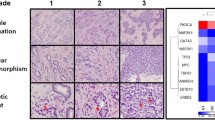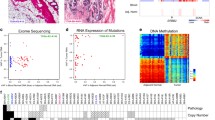Abstract
Mammary stroma plays an important role in facilitating the neoplastic transformation of epithelial cells, modulating integrity of the extracellular matrix, and maintaining genomic stability, but molecular mechanisms by which stroma affects epithelial structure and function are not well-defined. We used laser-assisted microdissection of paraffin-embedded breast tissues from 30 patients with breast disease and a panel of 52 microsatellite markers defining 26 chromosomal regions to characterize genomic patterns of allelic imbalance (AI) in disease-free tissue adjacent to sites of breast disease and to define genomic regions that may contain genes associated with early carcinogenic processes. The mean frequency of AI in histologically normal tissue adjacent to the primary carcinomas (15.4) was significantly higher than that in distant tissue from the same breast (3.7). The pattern of AI across all chromosomal regions differed between the adjacent tissue and primary tumor in every case. Unique AI events, observed only in tumor (15 of informative markers) or only in adjacent cells (10 of informative markers), were far more common than AI events shared between tumor and adjacent cells (~ 4). Levels of AI characteristic of advanced invasive carcinomas were already present in non-invasive ductal carcinomas in situ, and appreciable levels of AI were observed in adjacent non-neoplastic tissue at all pathological stages. Chromosome 11p15.1 showed significantly higher levels of AI in adjacent cells (p < 0.01), suggesting that this region may harbor genes involved in breast cancer development and progression. Our data indicate that genomic instability may be inherently greater in disease-free tissue close to developing tumors, which may have important implications for defining surgical margins and predicting recurrence.
Similar content being viewed by others
References
Tlsty TD, Hein PW: Know thy neighbor: stromal cells can contribute oncogenic signals. Curr Opin Genet Dev 11: 54–59, 2001
Coussens LM, Raymond WW, Bergers G, Laig-Webster M, Behrendtsen O, Werb Z, Caughey GH, Hanahan D: Inflammatory mast cells up-regulate angiogenesis during squamous epithelial carcinogenesis. Genes Dev 13: 1382–1397, 1999
Olumi AF, Grossfeld GD, Hayward SW, Carroll PR, Tlsty TD, Cunha GR: Carcinoma-associated fibroblasts direct tumor progression of initiated human prostatic epithelium. Cancer Res 59: 5002–5011, 1999
Bièche I, Lidereau R: Genetic alterations in breast cancer. Genes Chromosomes Cancer 14: 227–251, 1995
Persons DL, Robinson RA, Hsu PH, Seelig SA, Borell TJ, Hartmann LC, Jenkins RB: Chromosome-specific aneusomy in carcinoma of the breast. Clin Cancer Res 2: 883–888, 1996
Kauraniemi P, Bärlund M, Monni O, Kallioniemi A: New amplified and highly expressed genes discovered in the ERBB2 amplicon in breast cancer by cDNA microarrays. Cancer Res 61: 8235–8240, 2001
Deng G, Lu Y, Zlotnikov G, Thor AD, Smith HS: Loss of heterozygosity in normal tissue adjacent to breast carcinomas. Science 274: 2057–2059, 1996
Botti C, Pescatore B, Mottolese M, Sciarretta F, Greco C, Di Filippo F, Gandolfo GM, Cavaliere F, Bovani R, Varanese A, Cianciulli AM: Incidence of chromosomes 1 and 17 aneusomy in breast cancer and adjacent tissue: an interphase cytogenetic study. J Am Coll Surg 190: 516–525, 2000
Moinfar F, Man YG, Bratthauer GL, Ratschek M, Tavassoli FA: Genetic abnormalities in mammary ductal intraepithelial neoplasia-flat type (“clinging ductal carcinoma in situ”): a simulator of normal mammary epithelium. Cancer 88: 2072–2081, 2000
Försti A, Louhelainen J, Söderberg M, Wijkström H, Hemminki K: Loss of heterozygosity in tumour-adjacent normal tissue of breast and bladder cancer. Eur J Cancer 37: 1372–1380, 2001
Kurose K, Hoshaw-Woodard S, Adeyinka A, Lemeshow S, Watson PH, Eng C: Genetic model of multi-step breast carcinogenesis involving the epithelium and stroma: clues to tumour-microenvironment interactions. Hum Mol Genet 10: 1907–1913, 2001
Larson PS, de las Morenas A, Cupples LA, Huang K, Rosenberg CL: Genetically abnormal clones in histologically normal breast tissue. Am J Pathol 152: 1591–1598, 1998
Washington C, Dalbègue F, Abreo F, Taubenberger JK, Lichy JH: Loss of heterozygosity in fibrocystic change of the breast: genetic relationship between benign proliferative lesions and associated carcinomas. Am J Pathol 157: 323–329, 2000
Ellsworth DL, Ellsworth RE, Love B, Deyarmin B, Lubert SM, Mittal V, Hooke J, Shriver CD: Outer breast quadrants demonstrate increased levels of genomic instability. Ann Surg Oncol (in press)
Ellsworth DL, Shriver CD, Ellsworth RE, Deyarmin B, Somiari RI: Laser capture microdissection of paraffinembedded tissues. BioTechniques 34: 42–46, 2003
American Joint Committee on Cancer: AJCC Cancer Staging Manual, 6th edn. Greene FL, Page DL, Fleming ID, Fritz AG, Balch CM, Haller DG, Morrow M (eds) Springer, New York, 2002
Elston CW, Ellis IO: Pathological prognostic factors in breast cancer. I. The value of histological grade in breast cancer: experience from a large study with long-term follow-up. Histopathology 19: 403–410, 1991
Osborne RJ, Hamshere MG: A genome-wide map showing common regions of loss of heterozygosity/allelic imbalance in breast cancer. Cancer Res 60: 3706–3712, 2000
Ellsworth RE, Ellsworth DL, Lubert SM, Hooke J, Somiari RI, Shriver CD: High-throughput loss of heterozygosity mapping in 26 commonly deleted regions in breast cancer. Cancer Epidemiol Biomark Prev 12: 915–919, 2003
Ellsworth DL, Shriver MD, Boerwinkle E: Nucleotide sequence analysis of the apolipoprotein B 3’ VNTR. Hum Mol Genet 4: 937–944, 1995
Hecker KH, Roux KH: High and low annealing temperatures increase both specificity and yield in touchdown and stepdown PCR. BioTechniques 20: 478–485, 1996
Wang Y, Hung S-C, Linn JF, Steiner G, Glazer AN, Sidransky D, Mathies RA: Microsatellite-based cancer detection using capillary array electrophoresis and energytransfer fluorescent primers. Electrophoresis 18: 1742–1749, 1997
Medintz IL, Lee C-CR, Wong WW, Pirkola K, Sidransky D, Mathies RA: Loss of heterozygosity assay for molecular detection of cancer using energy-transfer primers and capillary array electrophoresis. Genome Res 10: 1211–1218, 2000
Vector Xpression Users Manual. InforMax–Invitrogen life science software, 2002
Jonckheere AR: A distribution free k-sample test against ordered alternatives. Biometrika 41: 133–145, 1954
Wild P, Knuechel R, Dietmaier W, Hofstaedter F, Hartmann A: Laser microdissection and microsatellite analyses of breast cancer reveal a high degree of tumor heterogeneity. Pathobiology 68: 180–190, 2000
Dairkee SH, Smith HS: Genetic analysis of breast cancer progression. J Mammary Gland Biol Neoplasia 1: 139–151, 1996
Marx J: Debate surges over the origins of genomic defects in cancer. Science 297: 544–546, 2002 (News)
Gong G, DeVries S, Chew KL, Cha I, Ljung BM, Waldman FM: Genetic changes in paired atypical and usual ductal hyperplasia of the breast by comparative genomic hybridization. Clin Cancer Res 7: 2410–2414, 2001
Balmain A, Gray J, Ponder B: The genetics and genomics of cancer. Nat Genet 33 Suppl: 238–244, 2003
Lakhani SR, Chaggar R, Davies S, Jones C, Collins N, Odel C, Stratton MR, O'Hare MJ: Genetic alterations in ‘normal’ luminal and myoepithelial cells of the breast. J Pathol 189: 496–503, 1999
Larson PS, de las Morenas A, Bennett SR, Cupples LA, Rosenberg CL: Loss of heterozygosity or allele imbalance in histologically normal breast epithelium is distinct from loss of heterozygosity or allele imbalance in co-existing carcinomas. Am J Pathol 161: 283–290, 2002
Moinfar F, Man YG, Arnould L, Bratthauer GL, Ratschek M, Tavassoli FA: Concurrent and independent genetic alterations in the stromal and epithelial cells of mammary carcinoma: implications for tumorigenesis. Cancer Res 60: 2562–2566, 2000
Ma X-J, Salunga R, Tuggle JT, Gaudet J, Enright E, McQuary P, Payette T, Pistone M, Stecker K, Zhang BM, Zhou Y-X, Varnholt H, Smith B, Gadd M, Chatfield E, Kessler J, Baer TM, Erlander MG, Sgroi DC: Gene expression profiles of human breast cancer progression. Proc Natl Acad Sci USA 100: 5974–5979, 2003
Kerangueven F, Noguchi T, Coulier F, Allione F, Wargniez V, Simony-Lafontaine J, Longy M, Jacquemier J, Sobol H, Eisinger F, Birnbaum D: Genome-wide search for loss of heterozygosity shows extensive genetic diversity of human breast carcinomas. Cancer Res 57: 5469–5474, 1997
Anbazhagan R, Fujii H, Gabrielson E: Allelic loss of chromosomal arm 8p in breast cancer progression. Am J Pathol 152: 815–819, 1998
Yuan B-Z, Zhou X, Durkin ME, Zimonjic DB, Gumundsdottir K, Eyfjord JE, Thorgeirsson SS, Popescu NC: DLC-1 gene inhibits human breast cancer cell growth and in vivo tumorigenicity. Oncogene 22: 445–450, 2003
Reis-Filho JS, Lakhani SR: The diagnosis and management of pre-invasive breast disease: genetic alterations in preinvasive lesions. Breast Cancer Res 5: 313–319, 2003
Li L, Li X, Francke U, Cohen SN: The TSG101 tumor susceptibility gene is located in chromosome 11 band p15 and is mutated in human breast cancer. Cell 88: 143–154, 1997
Li L, Cohen SN: tsg101: a novel tumor susceptibility gene isolated by controlled homozygous functional knockout of allelic loci in mammalian cells. Cell 85: 319–329, 1996
Partridge M, Pateromichelakis S, Phillips E, Emilion GG, A'Hern RP, Langdon JD: A case-control study confirms that microsatellite assay can identify patients at risk of developing oral squamous cell carcinoma within a field of cancerization. Cancer Res 60: 3893–3898, 2000
Wernert N, Locherbach C, Wellmann A, Behrens P, Hugel A: Presence of genetic alterations in microdissected stroma of human colon and breast cancers. Anticancer Res 21: 2259–2264, 2001
Kurose K, Gilley K, Matsumoto S, Watson PH, Zhou X-P, Eng C: Frequent somatic mutations in PTEN and TP53 are mutually exclusive in the stroma of breast carcinomas. Nat Genet 32: 355–357, 2002
Hamaguchi M, Meth JL, von Klitzing C, Wei W, EspositoD, Rodgers L, Walsh T, Welcsh P, King M-C, Wigler MH: DBC2, a candidate for a tumor suppressor gene involved in breast cancer. Proc Natl Acad SciUSA 99: 13647–13652, 2002
Zhou XZ, Lu KP: The Pin2/TRF1–interacting protein PinX1 is a potent telomerase inhibitor. Cell 107: 347–359, 2001
MacGrogan D, Levy A, Bova GS, Isaacs WB, Bookstein R: Structure and methylation-associated silencing of a gene within a homozygously deleted region of human chromosome band 8p22. Genomics 35: 55–65, 1996
Cabeza-Arvelaiz Y, Sepulveda JL, Lebovitz RM, Thompson TC, Chinault AC: Functional identification of LZTS1 as a candidate prostate tumor suppressor gene on human chromosome 8p22. Oncogene 20: 4169–4179, 2001
Fujiwara Y, Ohata H, Kuroki T, Koyama K, Tsuchiya E, Monden M, Nakamura Y: Isolation of a candidate tumor suppressor gene on chromosome 8p21.3–p22 that is homologous to an extracellular domain of the PDGF receptor beta gene. Oncogene 10: 891–895, 1995
Cunnick GH, Jiang WG, Gomez KF, Mansel RE: Lymphangiogenesis quantification using quantitative PCR and breast cancer as a model. Biochem Biophys Res Commun 288: 1043–1046, 2001
Shaughnessy JD Jr, Largaespada DA, Tian E, Fletcher CF, Cho BC, Vyas P, Jenkins NA, Copeland NG: Mrvil, a common MRV integration site in BXH2 myeloid leukemias, encodes a protein with homology to a lymphoidrestricted membrane protein Jaw1. Oncogene 18: 2069–2084, 1999
Oh H, Mammucari C, Nenci A, Cabodi S, Cohen SN, Dotto GP: Negative regulation of cell growth and differentiation by TSG101 through association with p21Cip1/WAF1. Proc Natl Acad Sci USA 99: 5430–5435, 2002
Shtivelman E: A link between metastasis and resistance to apoptosis of variant small cell lung carcinoma. Oncogene 14: 2167–2173, 1997
Author information
Authors and Affiliations
Rights and permissions
About this article
Cite this article
Ellsworth, D.L., Ellsworth, R.E., Love, B. et al. Genomic patterns of allelic imbalance in disease free tissue adjacent to primary breast carcinomas. Breast Cancer Res Treat 88, 131–139 (2004). https://doi.org/10.1007/s10549-004-1424-7
Issue Date:
DOI: https://doi.org/10.1007/s10549-004-1424-7




